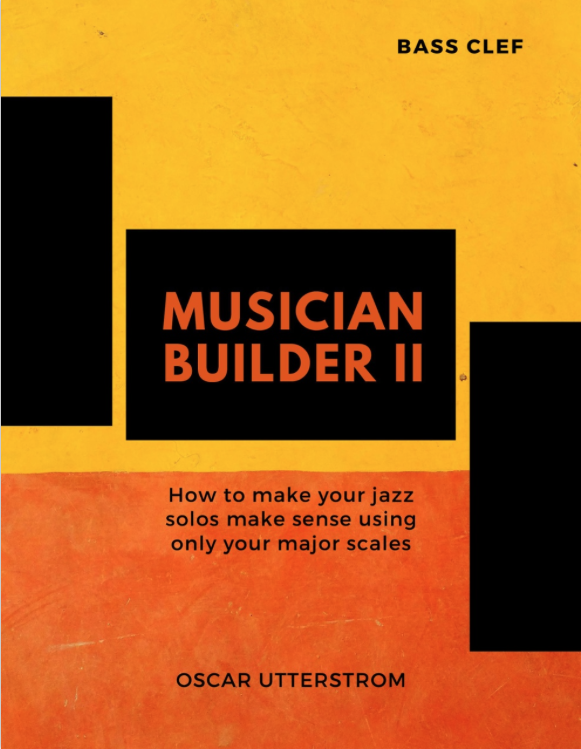Oscar Utterstrom
 Musician Builder II: How to make your jazz solos make sense using only your major scales
Musician Builder II: How to make your jazz solos make sense using only your major scales
Multiple instruments
Nashville, TN, United States
Publisher: Oscar Utterstrom
Date of Publication: 2019
URL: http://www.oscarutterstrom.com
Language: English
Method book. 66 pages. Online .mp3 tracks.
Primary Genre: Jazz Material - method
 Musician Builder II: How to make your jazz solos make sense using only your major scales
Musician Builder II: How to make your jazz solos make sense using only your major scalesMultiple instruments
Nashville, TN, United States
Publisher: Oscar Utterstrom
Date of Publication: 2019
URL: http://www.oscarutterstrom.com
Language: English
Method book. 66 pages. Online .mp3 tracks.
Primary Genre: Jazz Material - method
Nashville- and Oslo-based trombonist, bass trombonist, euphoniumist, and composer, Oscar Utterstrom has enjoyed a varied career in classical, jazz, and pop genres. His self-published PDF book targets the beginning to medium-level improvisor and is available in bass clef as well as in C, B-flat, and E-flat treble clef from his online store, $12.99 each at press time, including 22 play-along rhythm-section mp3 tracks. Thus musicians of varying instruments can easily collaborate on the exercises in a class or informal practice session. The play-along tracks of piano, bass, and drums are excellent. Each of the ten exercises are based on standard tunes, following an introductory pair of tracks, and are presented at two tempos. Two tracks use a bossa nova feel; the rest use a swing style. Full disclosure: I am the author of the improv method book Cutting the Changes: Jazz Improvisation via Key Centers (Kjos Music, 2006). So I am familiar with the author’s intent to simplify the path for musicians frustrated with intense theory demands often accompanying an entry into improv. Plusses of this book include clear music notation, lyrical music examples, superb play-along tracks, and the opportunity to solo over the chords of standard tunes. Only 9 of the 66 pages are written instruction; the rest is musical notation. So that’s an advantage or disadvantage depending wholly on what your own needs may be. By the eighth tune he intentionally graduates the improvisor to music in which the key centers and scales change as rapidly as within two bars, providing opportunity for greater challenge. External to the book is another plus: currently a link from Utterstrom’s home page leads to successive short videos (search on YouTube for “Intro to Musician Builder II”) demonstrating several concepts from the book, as well as to a downloadable sample of six pages and several play-along tracks. I encourage you to explore these directly for your own assessment. Hearing his trombone-playing in these videos adds an aural layer not available within the book's mp3 rhythm-tracks. There are seeming contradictions within the book. For example, I’m a fan, as is the author, of knowing how to build chord structures from chord symbols, thus recognizing the thirds and sevenths of chords and exploring how to navigate them within a solo. But for a pedagogical approach offering in its subtitle “how to make your jazz solos make sense using only your major scales,” teaching the theory of chord structures and of thirds and sevenths from the outset seems to promptly introduce elements that go beyond merely knowing your major scales. Similarly, as early as page 9, he emphasizes that the soloist should know the thirds and sevenths of each chord because they “override their respective note in the major scale. For example, if in the key of C there is an E7 chord, you will play G-sharp (major third of E7) instead of G (part of C major scale).” This not only adds considerable mental obligation for the newer soloist, though a sheet of the needed tones is provided to match each tune, but also contradicts the melodic color of so many standard tunes that might land purposefully on the G natural as the sharp-ninth of an E7 below it. The evocative colors of so many composers’ own melodies are not available to the soloist who conforms by theory to the strict diatonicism of each chord. The author also emphasizes the importance of starting most improv-solo lines on the third or seventh of a given chord. This again requires more than knowledge of major scales and introduces an artificial direction of solo line that is certainly not borne out of the melodies of most blues tunes or of The Great American Songbook. When Utterstrom introduces a blues in F (page 24), pointing out the need to lower the seventh from E to E-flat, he speaks of the importance of using the resulting F Mixolydian scale rather than the F major scale. Thus he again deviates from his major-scale-only approach, which would necessarily have to focus on the B-flat major scale, same pitches as F Mixolydian, so as to remain consistent with the subtitle of the book. Many musicians with a bit of theory already in hand will not find any of the above elements a concern. The author's organized delivery offers a clear path to growth, even if more challenging than his subtitle may suggest. I certainly enjoyed the challenge of shifting my own soloing style to match his guidelines and grew in the discipline of the process!
Reviewer: Antonio Garcia
Review Published June 24, 2023
Review Published June 24, 2023